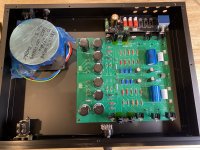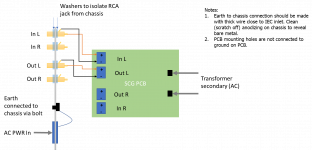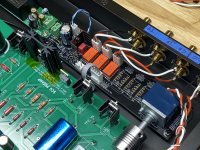Yes, pretty much. You can try measuring them. For example, see measurements in post 254.
From the ones you listed:
840/830: look decent.
LND150: Looks excellent. Very low input capacitance. Watch the SOA and drain current. Probably no more than 10 mA at 40Vds.
K170: I explored it in this thread. See the LSK special. It has a unique sound. I personally like other FETs mentioned in the circuit, but depending upon the rest of your system, this may be a good choice.
The TO-92 JFETs probably cannot do more than 400 mW. That's what I recall ZM has mentioned and also what the spec sheet says. If you have valuable ones (like K170), don't push them too hard. I have pushed the STQ parts to 800 mW and they haven't blown up, but they get really hot, like too hot to touch. In the circuit, at the operating point, the STQ1NK80ZR-AP is at 450-500 mW. Their spec sheet claims > 1W capability, which I haven't tested . But this is the best part: if I blow up the STQ part, I won't be sorry. When my 10Y tubes inevitably fail, I will be crying.
. But this is the best part: if I blow up the STQ part, I won't be sorry. When my 10Y tubes inevitably fail, I will be crying.
IRFP9610: P-channel, good for bottom FET position.
You are generally looking for a Vds capability of at least 40V, and current capability of at least 10 mA. Any FET that can do those can be a candidate.Rather than spending money for MosFets, I'd rather use what's in my parts box, so I'm looking for recommendations. I have old school IRF840, 830, 711, 530, IRFP9610, 9540, 9140, LND150, ZVN0545. I have several fets for possible use as the input stage (or not), K170, K369, J174, 2N5462, U310 and J201. I have IXCP10M and DN2540 for the CCS. I know that's a bit of a list, but general guidance would great...I'm more of a tube guy.
From the ones you listed:
840/830: look decent.
LND150: Looks excellent. Very low input capacitance. Watch the SOA and drain current. Probably no more than 10 mA at 40Vds.
K170: I explored it in this thread. See the LSK special. It has a unique sound. I personally like other FETs mentioned in the circuit, but depending upon the rest of your system, this may be a good choice.
The TO-92 JFETs probably cannot do more than 400 mW. That's what I recall ZM has mentioned and also what the spec sheet says. If you have valuable ones (like K170), don't push them too hard. I have pushed the STQ parts to 800 mW and they haven't blown up, but they get really hot, like too hot to touch. In the circuit, at the operating point, the STQ1NK80ZR-AP is at 450-500 mW. Their spec sheet claims > 1W capability, which I haven't tested
 . But this is the best part: if I blow up the STQ part, I won't be sorry. When my 10Y tubes inevitably fail, I will be crying.
. But this is the best part: if I blow up the STQ part, I won't be sorry. When my 10Y tubes inevitably fail, I will be crying. IRFP9610: P-channel, good for bottom FET position.
Thanks, that will give me a good place to start. I also have a few prized tubes that will never be replaced, and truly missed. Real WE300b, WE101d and Cunningham 01a. These all use $$$$ custom wound output xfmrs. These are so excellent line stage tubes that the MosFet will have a hard time bettering.
Maybe sometime I can score a few STQ1NK80ZR-AP to try
Maybe sometime I can score a few STQ1NK80ZR-AP to try
I am happy to send you a few STQ1NK80ZR-AP to try.
BTW, I went on the well-traveled path of 26->01a->10Y. I have even tried 300B and 45 tubes in the preamp. My favorite is the 10Y. But I was tired of seeking out these 100-year old valves and I've been building valves for only about a year, so one can only imagine the frustration of others. That is when I started looking for alternatives and this circuit is the result of that search. Honestly speaking, I am surprised at the level of performance from ordinary FETs. In my current system, the SCG preamp makes no apologies to the 10Y about taking its place. Really, it is a matter of taste and system synergy. The 10Y (to a lesser extent) and other tubes sweeten things up a bit and take the edge off. Whether the system as a whole needs it and whether you need more sugar is going to determine what you like. I find this especially true in the treble region. Sometimes the speakers are up to it and need no more rounding, other times the treble is not the smoothest and that little bit of softening makes everything better.
BTW, I went on the well-traveled path of 26->01a->10Y. I have even tried 300B and 45 tubes in the preamp. My favorite is the 10Y. But I was tired of seeking out these 100-year old valves and I've been building valves for only about a year, so one can only imagine the frustration of others. That is when I started looking for alternatives and this circuit is the result of that search. Honestly speaking, I am surprised at the level of performance from ordinary FETs. In my current system, the SCG preamp makes no apologies to the 10Y about taking its place. Really, it is a matter of taste and system synergy. The 10Y (to a lesser extent) and other tubes sweeten things up a bit and take the edge off. Whether the system as a whole needs it and whether you need more sugar is going to determine what you like. I find this especially true in the treble region. Sometimes the speakers are up to it and need no more rounding, other times the treble is not the smoothest and that little bit of softening makes everything better.
To make a tube really shine, you need a very good output transformer. This means multi turn/layer "multi-filer" windings and good lamination material (cobalt etc.) and a master winder. Not to may left in the world. My amps are SE 211 and Pass F7. Maybe someday I will be able to score some V-fets and try them. To my ears MosFets add a glare. While HF extension is better with a fet, it's hard to give up the silky smooth midrange. I've played cello all my life and tubes just seem to get it right...but as they say...different strokes for different folks.
I haven't tried a really good transformer. Maybe one day. I have heard a 300B tube amp in my system, so I know the sound. To my ears, the VFET shows more. More of what the performer is doing, more of the heart and soul they are putting into the performance. When I listen to it, I can really feel that they are giving it their all, leaving nothing behind. Everything else I've heard, while really outstanding, doesn't take me there.
I keep an open mind. This is entertainment for me. There is always tomorrow, there will always be a new amp and preamp. Loads of fun to be had. Lots of new friends to be made 🙂
I keep an open mind. This is entertainment for me. There is always tomorrow, there will always be a new amp and preamp. Loads of fun to be had. Lots of new friends to be made 🙂
Last edited:
I just got my board a couple days back. Shopping for parts now. Have you tried different gain devices?SCG is getting close to a real home.
The lid will need a circle cutout so the Toroidy can peek through approximately 10mm. An additional small 10va trafo will supply power for the I-Select board.
Here's a wiring diagram. The way I have wired it, the signal ground (or reference, as I like to think about it) is not connected to chassis ground. Signal reference and power ground are tied together on the PCB, but you don't have to think about that.
After the RCA jacks are on the chassis, check if there is any continuity between the jack and the chassis. Check each jack. They should be completely isolated from the chassis, otherwise you might get ground loops.

After the RCA jacks are on the chassis, check if there is any continuity between the jack and the chassis. Check each jack. They should be completely isolated from the chassis, otherwise you might get ground loops.
Attachments
Best practice is not to leave the active circuit floating. Suggest you tie the common signal/PS ground to chassis ground with a 10 ohm resistor. A CL-60 thermistor would do as a link too.
Steve, yes that works too and there are various ways to do that. Simple resistor or CL-60 works.
SCG is singing beautifully in her new home driving Big MoFo amps. Just a few minor details to button up like the front panel indicator leds for source selection. Now I can easily experiment “rolling” transistors.
Thanks again for sharing this Preamp Rahul!!
Thanks again for sharing this Preamp Rahul!!
Attachments
Yes, 50k is just about right. I’d replace the input 47k resistor with 1Meg.@ra7, is 50k log pot fine for the volume control? or do you recommend even lower?
Interesting. I have populated the bypass caps position using vishay mkp 0.1uf while waiting for the 50uf electrolytic caps to arrive. Not sure how this small value bypass will affect the outcome though.I plan to use a 10 uF film cap (Wima DC Link in C102/202 only.
- Home
- Amplifiers
- Pass Labs
- Schade Common Gate (SCG) Preamp




